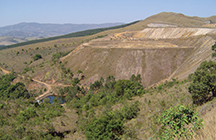Soil Science Society of America
5585 Guilford Road • Madison, WI 53711-5801 • 608-273-8080 • Fax 608-273-2021
www.soils.org
Twitter | Facebook | Soils Matter Blog
NEWS RELEASE
Contact: Hanna Jeske, Associate Director of Marketing and Brand Strategy, 608-268-3972, hjeske@sciencesocieties.org
When Oxygen Makes Pollution Worse
MADISON, WI, SEPTEMBER 28, 2009 – Oxidation of sulfides in mining wastes produces high concentrations of sulfate, iron, and other metals, and frequently also very low pH values. Compared to fine-grain mine tailings, produced in ore treatment by flotation and other techniques, waste rock is just displaced material comprising large size particles and deposited in waste rock piles. In waste rock piles with high permeability and sulfide content, the oxidation of sulfides produces heat, and temperatures may reach very high values. Air with oxygen is sucked into the pile in convection, and this accelerates the pyrite oxidation rate. Generation of contaminants is then much higher than in the oxygen diffusion typical for mine tailings, and environmental impact may be severe.
J. César da Silva and E. Amaral Vargas Jr. (both of Dep. of Civil Engineering, Pontifical Catholic University, Rio de Janeiro, Brazil), and O. Sracek (OPV s.r.o. [Protection of Groundwater Ltd.] and Masaryk University, Czech Republic) describe details of the development of the THERMOX program and its application in simulation of the behavior of waste rock piles in the November issue of Vadose Zone Journal.
The THERMOX program enables the evaluation of environmental impact of waste rock piles under different scenarios (e.g., varying climatic conditions, different geometries of a pile, etc.). On a subsequent stage, different mitigation and remediation options can also be evaluated using the program. The program is highly versatile and may be used in other applications as well, including sequestration of CO2 and multiphase transport of organic contaminants.
The waste rock pile at the Doyon Mine site in northern Québec, Canada was used for the analyses. Both field studies and numerical modeling revealed a zone of fast convective oxygen supply close to the pile slope and a zone of much slower oxygen supply in the pile core. Convective oxygen supply close to the pile slope results in high temperatures and concentrations of dissolved contaminants. Internal evaporation further enriches the already very concentrated pore solutions. Presence of internal evaporation has also been confirmed by the application of stable isotopes deuterium and oxygen-18 at the Doyon Mine site.
 Scientists from Civil Engineering Department at Pontifical Catholic University in Rio de Janeiro, Brazil have been working for long time on numerical modeling of environmental and geomechanical problems. The program THERMOX for modeling of processes in waste rock piles with convective oxygen supply was developed by J. César da Silva in the frame of his Ph.D. thesis under supervision of E.A. Vargas, Jr. and O. Sracek. The third author worked on waste rock piles characterization and modeling at Université Laval, Quebéc, Canada, with R. Lefebvre and late P. Gélinas. Data from their study site, the Doyon Mine, were used for verification of the THERMOX program. Currently he works at the consulting company OPV s.r.o. (Protection of Groundwater Ltd) in Prague, Czech Republic, and at the Institute of Geological Sciences, Faculty of Science, Masaryk University in Brno, Czech Republic.
Scientists from Civil Engineering Department at Pontifical Catholic University in Rio de Janeiro, Brazil have been working for long time on numerical modeling of environmental and geomechanical problems. The program THERMOX for modeling of processes in waste rock piles with convective oxygen supply was developed by J. César da Silva in the frame of his Ph.D. thesis under supervision of E.A. Vargas, Jr. and O. Sracek. The third author worked on waste rock piles characterization and modeling at Université Laval, Quebéc, Canada, with R. Lefebvre and late P. Gélinas. Data from their study site, the Doyon Mine, were used for verification of the THERMOX program. Currently he works at the consulting company OPV s.r.o. (Protection of Groundwater Ltd) in Prague, Czech Republic, and at the Institute of Geological Sciences, Faculty of Science, Masaryk University in Brno, Czech Republic.
Ongoing research at Pontifical Catholic University in cooperation with the company OPV s.r.o. will explore the use of THERMOX for the study of other sites in Brazil, the Czech Republic, and elsewhere, such as the waste rock pile in Poços de Caldas.
Photo: Waste rock pile from past uranium mining in Poços de Caldas, Brazil, where efforts have been made to minimize acid leachate seepage at the pile base.
Vadose Zone Journal is an international, gold open access journal that serves as an outlet for interdisciplinary research and assessment of the vadose zone, the portion of the critical zone that comprises the earth's critical living surface down to groundwater.